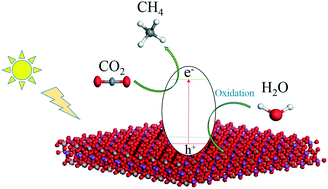Boosted CO2 photoreduction to methane via Co doping in bismuth vanadate atomic layers†
Abstract
CO2 photoreduction to valuable hydrocarbons is attractive and promising. Nevertheless, the photoactivity has been pretty low to date, and deeper insights into improving CO2 conversion efficiency remain a challenge. Here, BiVO4 atomic layers have been synthesized as ideal platforms to investigate the correlation between the electronic structures and activities for CO2 photoreduction. Cobalt (Co) is then deliberately doped in BiVO4 atomic layers to adjust the electronic structures. XPS analysis, CO2 TPD and electrochemical experiments indicate that Co doping makes the electron densities around O anions increase, which could likely facilitate CO2 activation and electron transfer to CO2 molecules, while photoelectrochemical and photocatalytic oxygen evolution experiments demonstrate that Co doping could also promote water oxidation reactions. Further investigations by density functional theory calculation reveal that Co doping results in the generation of new defect levels above the Fermi level, inferring that a higher hole concentration is favorable for water oxidation, and the doped Co 3d orbits located at the top of valence bands might serve as active centers for water oxidation. As a result, Co-doped BiVO4 atomic layers achieve an efficient and stable CH4 production rate of 23.8 μmol g−1 h−1 under atmospheric CO2 concentration (400 ppm), which is about three times the activity of pristine BiVO4 atomic layers. This work might help to gain deeper insights into the design of CO2 photoreduction catalysts.



 Please wait while we load your content...
Please wait while we load your content...